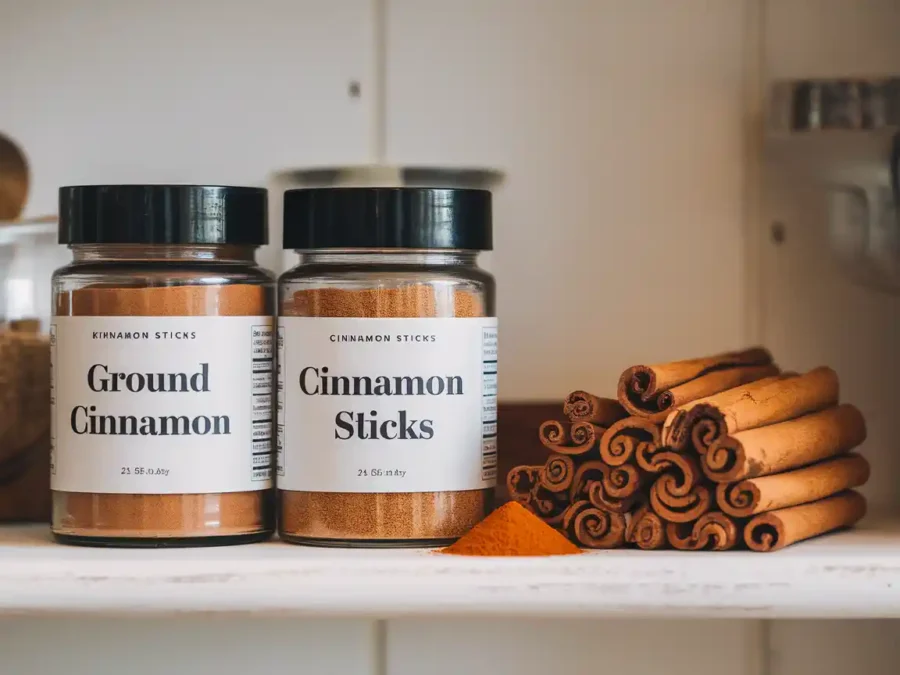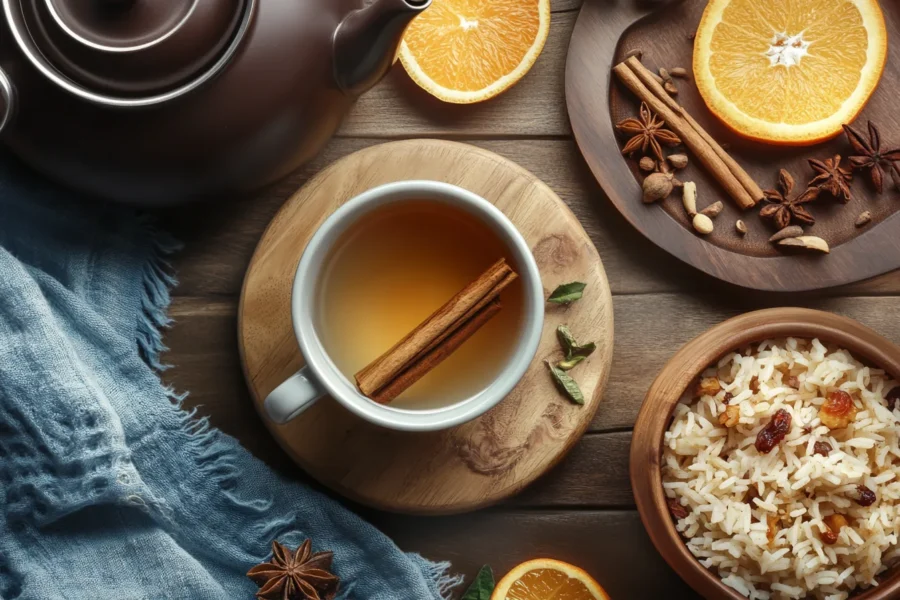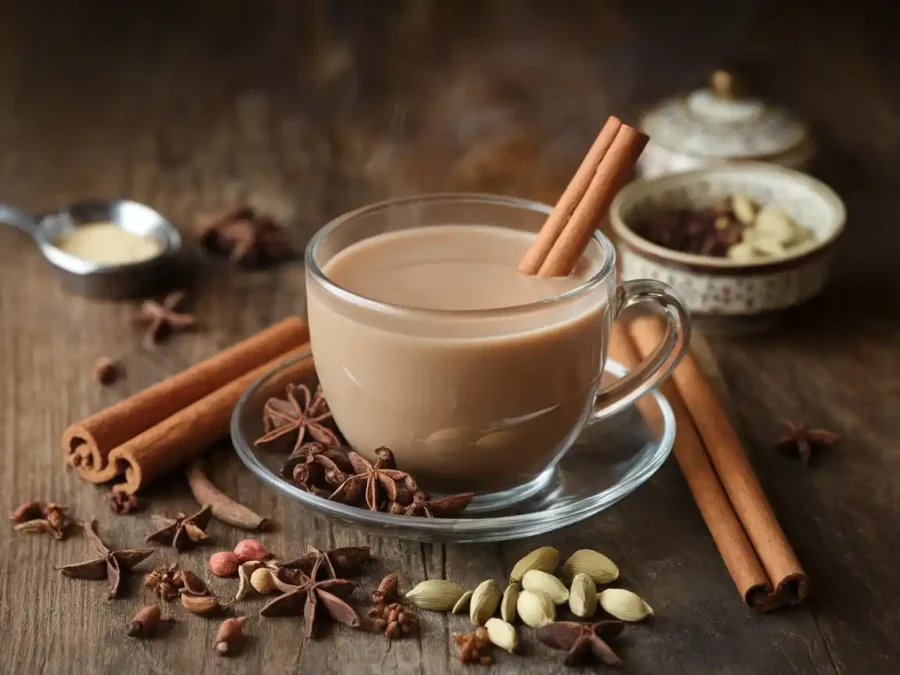Cinnamon is one of the most beloved spices worldwide, bringing warmth, flavor, and a touch of nostalgia to countless dishes and beverages. But if you’ve ever stood in the spice aisle debating between ground cinnamon and cinnamon sticks, you’re not alone. Are they interchangeable? Which one should you use? And why do they even come in these two forms? Let’s dive deep into understanding the differences between cinnamon and cinnamon sticks and uncover when and how to use each.
Table of Contents
Introduction to Cinnamon and Cinnamon Sticks
Cinnamon, derived from the inner bark of trees in the genus Cinnamomum, has been treasured for centuries. Its distinct aroma and flavor make it a staple in both sweet and savory recipes, but not all cinnamon is the same.
Ground cinnamon is what you’ll commonly find in shakers or prepackaged containers, while cinnamon sticks, often referred to as quills, are the spice in its purest form. Both share a warm, spicy-sweet essence, but they’re used differently depending on the recipe or purpose.
“Cinnamon in any form is like a hug for your senses it’s comfort, nostalgia, and joy wrapped into one.”
While they may seem interchangeable, understanding their unique characteristics can make all the difference in your culinary creations.
Understanding Cinnamon: Forms and Uses
Before we compare the two, let’s understand the basics of each form.
Ground Cinnamon: What It Is and How It’s Made
Ground cinnamon is simply cinnamon sticks that have been finely ground into a powder. This form is incredibly convenient because it’s ready to use and blends seamlessly into recipes.
It’s perfect for recipes where the spice needs to distribute evenly, like cookies, cakes, and sauces. The downside? Once ground, cinnamon loses its potency faster than sticks because its essential oils evaporate more quickly when exposed to air.
💡 Pro Tip: Always store ground cinnamon in an airtight container to retain its freshness longer.
Cinnamon Sticks: The Unprocessed Option
Cinnamon sticks are the whole bark of the cinnamon tree, rolled into the iconic quill shape during processing. These sticks are incredibly aromatic, and their flavor is released slowly, making them ideal for recipes that require simmering or infusing, such as mulled wine or curries.
Unlike ground cinnamon, sticks are more versatile they can be reused in some cases and even double as a decorative or crafting element.
“Think of cinnamon sticks as the jazz musicians of the spice world: they take their time, improvise, and leave a lingering note of flavor.”
Key Differences

At first glance, both forms seem similar, but their distinctions lie in processing, flavor delivery, and storage.
Processing and Texture Differences
The most obvious difference is their form. Ground cinnamon is finely powdered, while cinnamon sticks are unprocessed bark. This distinction affects how each is used in recipes ground cinnamon blends in, while sticks infuse gradually.
Aroma and Flavor Profiles
Cinnamon sticks tend to have a fresher and more nuanced flavor compared to their powdered counterpart. Ground cinnamon, though potent initially, can sometimes taste flat if stored too long.
Shelf Life and Storage Needs
Cinnamon sticks last much longer than ground cinnamon when stored properly. While ground cinnamon loses its flavor after about six months to a year, sticks can remain fresh for up to two years.
Culinary Applications and Techniques
Ground cinnamon is the go-to for quick, no-fuss recipes like pancakes or cookies. Sticks, on the other hand, are best for recipes that benefit from slow cooking or steeping, like stews, rice dishes, or tea.
Health Benefits
Beyond their culinary uses, both forms of cinnamon offer a wealth of health benefits.
Shared Nutritional Properties
Both cinnamon and cinnamon sticks are loaded with antioxidants, which help combat free radicals in the body. They also have anti-inflammatory properties, support healthy blood sugar levels, and promote heart health.
Unique Advantages of Using Cinnamon Sticks
Because cinnamon sticks are less processed, they often retain more of their essential oils, which carry the majority of the health benefits. They’re also free from additives that some commercial ground cinnamon might contain.
When to Choose Ground Cinnamon vs. Cinnamon Sticks
The choice between ground cinnamon and cinnamon sticks depends largely on what you’re making and how you plan to use the spice. Let’s break it down to simplify your decision-making process.
Best Scenarios for Ground Cinnamon
Ground cinnamon shines when you need a spice that mixes seamlessly into your recipe. It’s quick, easy to measure, and works wonders in baking, cooking, and even crafting your favorite spice blends.
- Baking: Need to whip up some cinnamon rolls or cookies? Ground cinnamon evenly distributes throughout the dough or batter, ensuring a consistent flavor in every bite.
- Quick Recipes: For dishes like oatmeal, pancakes, or smoothies, a sprinkle of ground cinnamon adds a burst of warmth without any extra steps.
- Spice Blends: When making chai masala, pumpkin spice, or dry rubs for meat, ground cinnamon combines effortlessly with other spices.
“Ground cinnamon is like the instant coffee of spice quick, reliable, and perfect when you’re in a rush.”
💡 Tip: Ground cinnamon is also ideal for dusting over dishes, like French toast or hot cocoa, for a quick aromatic finish.
Ideal Uses for Cinnamon Sticks
Cinnamon sticks take the lead in recipes that require slow cooking, steeping, or infusing. Their whole form allows them to release flavor gradually, making them perfect for creating depth and complexity.
- Beverages: Drop a cinnamon stick into hot tea, coffee, or mulled wine, and let it infuse while you sip. It’s especially great for recipes like spiced cider or chai.
- Savory Dishes: Add a stick to curries, stews, or soups for a rich, warm undertone.
- Decorative Use: Cinnamon sticks are excellent for garnishing cocktails or holiday desserts. They can also double as a natural stirrer, adding both function and flair.
“Cinnamon sticks are the slow cookers of spices patient, thorough, and oh-so-rewarding.”

Common Problems
Even with a spice as magical as cinnamon, you might encounter a few hiccups. Here’s how to tackle them.
Loss of Flavor in Ground Cinnamon
Ground cinnamon can lose its flavor and aroma if stored improperly or kept for too long. If your ground cinnamon smells faint or tastes dull, it’s time for a fresh batch.
How to Prevent This:
- Store ground cinnamon in an airtight container in a cool, dark place.
- Avoid exposing it to heat or humidity, which can accelerate the loss of essential oils.
💡 Did You Know? Smelling your cinnamon is the easiest way to test its freshness. If the aroma isn’t strong, it won’t deliver in your recipes.
Breaking or Grinding Cinnamon Sticks Easily
Cinnamon sticks can be tough to break or grind, making them challenging for some recipes. The trick is to soften them slightly before use.
Easy Fixes:
- Toast the stick lightly in a dry pan to release its natural oils and make it more brittle.
- Soak the stick in warm water for a few minutes to soften it. Once pliable, you can grind it using a spice grinder or mortar and pestle.
“Don’t wrestle with a cinnamon stick work with it, not against it.”
Sustainable Sourcing and Quality Tips for Both Forms

Choosing high-quality, sustainably sourced cinnamon not only enhances your recipes but also supports ethical farming practices.
How to Identify High-Quality Cinnamon
The best cinnamon is rich in aroma and vibrant in color. Whether buying ground cinnamon or sticks, here’s what to look for:
- Ground Cinnamon: A deep reddish-brown hue and a strong, sweet aroma are indicators of freshness.
- Cinnamon Sticks: Look for sticks that are tightly rolled, with a smooth texture and an even color.
💡 Pro Tip: Ceylon cinnamon is often considered the “true cinnamon” and has a more delicate flavor compared to the stronger, spicier cassia variety.
Ethical and Sustainable Cinnamon Practices
Sustainable cinnamon farming helps protect the environment and ensures fair wages for farmers. When purchasing cinnamon:
- Look for labels like “fair trade” or “organic.”
- Support brands that prioritize sustainable practices, such as replanting cinnamon trees.
“Every cinnamon stick has a story choose one that supports both the planet and its people.”
Frequently Asked Questions
Here are answers to some of the most common questions about cinnamon and cinnamon sticks to help you make the most of this versatile spice.
Can you substitute cinnamon sticks for ground cinnamon?
Yes, you can substitute one for the other, but keep in mind their differences in flavor release and intensity. Typically, one cinnamon stick equals about ½ to 1 teaspoon of ground cinnamon. Remember, ground cinnamon incorporates into recipes instantly, while sticks take time to infuse.
How long does cinnamon last?
Ground cinnamon typically retains its flavor for about six months to a year if stored properly in an airtight container away from heat and light. Cinnamon sticks, on the other hand, can last up to two years, making them a better long-term option.
Which type of cinnamon is better for baking?
Ground cinnamon is the go-to for baking since it blends seamlessly into batters and doughs. Cinnamon sticks are better for infusing liquids or creating a subtle flavor in recipes that require slow cooking.
What’s the difference between Ceylon and cassia cinnamon?
Ceylon cinnamon, often called “true cinnamon,” has a milder and sweeter flavor, while cassia cinnamon is spicier and more robust. Both are widely used, but Ceylon is preferred for delicate desserts and beverages, while cassia works well in bold, savory dishes.
Can cinnamon sticks be reused?
Yes! After using a cinnamon stick, rinse it under warm water and let it dry completely. You can reuse it once or twice more, though its flavor will become milder with each use.
How do I grind cinnamon sticks at home?
To grind cinnamon sticks, lightly toast them in a dry pan, then use a spice grinder or a mortar and pestle. This method releases their natural oils, giving you a fresher and more potent ground cinnamon than store-bought options.
Conclusion: Choosing the Right Cinnamon for Your Needs
Cinnamon, whether ground or in stick form, is an indispensable part of the spice rack. But understanding the differences between these two forms allows you to choose the right one for every occasion.
Ground cinnamon is your best friend for quick recipes and baked goods where even distribution and ease of use are key. It’s perfect for adding a touch of warmth to your morning oatmeal, spicing up pancakes, or enhancing the flavor of a homemade spice blend. However, its shorter shelf life and potential loss of freshness over time make it better suited for regular use.
Cinnamon sticks, on the other hand, are all about infusing bold, long-lasting flavor. They shine in slow-cooked dishes, teas, and even decorative settings. Their ability to release flavor gradually makes them ideal for recipes that benefit from a lingering, aromatic spice. Plus, their impressive shelf life and reusable nature make them a more sustainable option.
“Think of ground cinnamon as the instant solution, while cinnamon sticks are the slow-build storytellers of the spice world.”
Ultimately, whether you choose ground cinnamon or cinnamon sticks depends on your recipe and your personal preferences. Either way, cinnamon will always bring warmth, flavor, and a touch of magic to your kitchen. So, the next time you cook, bake, or craft, let this versatile spice work its wonders one sprinkle or stick at a time.
“With cinnamon in your pantry, every dish becomes an opportunity to create something extraordinary.” 😊

